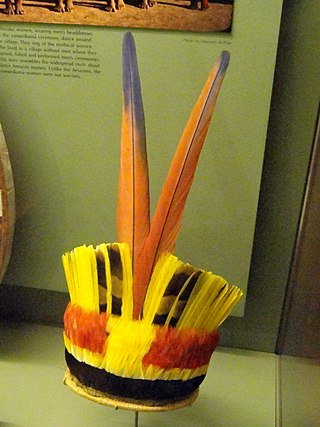
Shamanism or samanism is a religious practice that involves a practitioner interacting with the spirit world through altered states of consciousness, such as trance. The goal of this is usually to direct spirits or spiritual energies into the physical world for the purpose of healing, divination, or to aid human beings in some other way.

Spirit possession is an unusual or an altered state of consciousness and associated behaviors which are purportedly caused by the control of a human body by spirits, ghosts, demons, angels, or gods. The concept of spirit possession exists in many cultures and religions, including Buddhism, Christianity, Haitian Vodou, Dominican 21 Divisions, Hinduism, Islam, Wicca, and Southeast Asian, African, and Native American traditions. Depending on the cultural context in which it is found, possession may be considered voluntary or involuntary and may be considered to have beneficial or detrimental effects on the host. In a 1969 study funded by the National Institute of Mental Health, spirit possession beliefs were found to exist in 74% of a sample of 488 societies in all parts of the world, with the highest numbers of believing societies in Pacific cultures and the lowest incidence among Native Americans of both North and South America. As Pentecostal and Charismatic Christian churches move into both African and Oceanic areas, a merger of belief can take place, with demons becoming representative of the "old" indigenous religions, which the Christian ministers attempt to exorcise.

A curandero is a traditional native healer or shaman found primarily in Latin America and also in the United States. A curandero is a specialist in traditional medicine whose practice can either contrast with or supplement that of a practitioner of Western medicine. A curandero is claimed to administer shamanistic and spiritistic remedies for mental, emotional, physical and spiritual illnesses. Some curanderos, such as Don Pedrito, the Healer of Los Olmos, make use of simple herbs, waters, or mud to allegedly effect their cures. Others add Catholic elements, such as holy water and pictures of saints; San Martin de Porres for example is heavily employed within Peruvian curanderismo. The use of Catholic prayers and other borrowings and lendings is often found alongside native religious elements. Many curanderos emphasize their native spirituality in healing while being practicing Catholics. Still others, such as Maria Sabina, employ hallucinogenic media. Most of the concepts related to curanderismo are Spanish words, often with medieval, vernacular definitions.

Filipino shamans, commonly known as babaylan, were shamans of the various ethnic groups of the pre-colonial Philippine islands. These shamans specialized in communicating, appeasing, or harnessing the spirits of the dead and the spirits of nature. They were almost always women or feminized men. They were believed to have spirit guides, by which they could contact and interact with the spirits and deities and the spirit world. Their primary role were as mediums during pag-anito séance rituals. There were also various subtypes of babaylan specializing in the arts of healing and herbalism, divination, and sorcery.

Xingu people are indigenous people of Brazil living near the Xingu River. They have many cultural similarities despite their different ethnicity. Xingu people represent fifteen tribes and all four of Brazil's indigenous language groups, but they share similar belief systems, rituals and ceremonies.
The Yawalapiti are an indigenous tribe in the Amazonian Basin of Brazil. The name is also spelled Iaualapiti in Portuguese. The current village Yawalapiti is situated more to the south, between the Tuatuari and Kuluene River. Their population in 2011 was 156, down from a 2010 population of 237 (2010) but up from a low of 25 in 1954.
The Kuikuro are an indigenous people from the Mato Grosso region of Brazil. Their language, Kuikuro, is a part of the Cariban language family. The Kuikuro have many similarities with other Xingu tribes. They have a population of 592 in 2010, up from 450 in 2002.
The Nahua of La Huasteca is an indigenous ethnic group of Mexico and one of the Nahua peoples. They live in the mountainous area called La Huasteca which is located in north eastern Mexico and contains parts of the states of Hidalgo, Veracruz and Puebla. They speak one of the Huasteca Nahuatl dialects: western, central or eastern Huasteca Nahuatl.

The Jivaroan peoples are the indigenous peoples in the headwaters of the Marañon River and its tributaries, in northern Peru and eastern Ecuador. The tribes speak the Chicham languages.

The Aweti people are a group of Native Americans living in the Xingu Indigenous Park, close to the headwaters of the Xingu River in Brazil. The Aweti inhabit two villages in the region. One is called Tazu’jyretam, and the other is unnamed. Tazu’jyretam is the main village of the Aweti people, and has been inhabited since at least the 19th century. Tazu’jyretam also has a small port. Both of these villages are located in an area between the Curisevo and Tuatuarí rivers, which feed into the Xingu further upstream. Their population was 196 in 2011, up from 140 in 2006.

The Wauja or Waura are an indigenous people of Brazil. Their language, Waurá, is an Arawakan language. They live in the region near the Upper Xingu River, in the Xingu Indigenous Park in the state of Mato Grosso, and had a population of 487 in 2010.
Vegetalismo is a term used to refer to a practice of mestizo shamanism in the Peruvian Amazon in which the shamans—known as vegetalistas—are said to gain their knowledge and power to cure from the vegetales, or plants of the region. Many believe to receive their knowledge from ingesting the hallucinogenic, emetic brew ayahuasca.

Huka-huka is a Brazilian folk wrestling style of the indigenous people of Xingu, in the state of Mato Grosso. It is performed as a ritual fight during the ceremony of Kuarup.
Mun or Munism is the traditional polytheistic, animist, shamanistic and syncretic religion of the Lepcha people. It predates the 7th century Lepcha conversion to Lamaistic Buddhism, and since that time, the Lepcha have practiced it together with Buddhism. Since the arrival of Christian missionaries in the nineteenth century, Mun traditions have been followed alongside that religion as well. The traditional religion permits incorporation of Buddha and Jesus Christ as deities, depending on household beliefs.

Kev Dab Kev Qhuas is the common ethnic religion of the Miao people, best translated as the "practice of spirituality". The religion is also called Hmongism by a Hmong American church established in 2012 to organize it among Hmong people in the United States.
Ana Mariella Bacigalupo is a Peruvian anthropologist. She is a full professor at the State University of New York at Buffalo and has previously taught throughout the USA and in Chile. Her research primarily focuses on the shamans or machis of the Mapuche community of Chile, and the ways shamanic practices and beliefs are affected by and influence communal experiences of state power, mythical history, ethics, gender, justice, and identity.
Shamanism in China can be traced back to the early Shang Dynasty. During the Shang Dynasty, it was common for shamans to hold positions as low ranking state officials, often serving as spirit mediums, fortune-tellers, healers, and exorcists. Shamanism continued to proliferate throughout China until the Sui Dynasty, when Confucianism and Daoism began to take over religious thought and tradition. Daoists saw shamans as a threat since they were often employed to perform similar rituals and exorcisms. Eventually Shamanism declined drastically in the Song dynasty once Daoism became more influential in the Song China's courts. Daoist traditions and rituals gained influence and shamans were seen as false healers who exploited their clients for financial gain. Over time shaman healers, who were mainly illiterate, were replaced by doctors and medical experts who were trusted for their education and literacy.
Shamanism is a religious practice present in various cultures and religions around the world. Shamanism takes on many different forms, which vary greatly by region and culture and are shaped by the distinct histories of its practitioners.

The Durin-gut, also called the Michin-gut and the Chuneun-gut, is the healing ceremony for mental illnesses in the Korean shamanism of southern Jeju Island. While commonly held as late as the 1980s, it has now become very rare due to the introduction of modern psychiatry.

Shaking tent ceremony is a ritual of some of the indigenous people in North America that is used to connect the people with the spirit realm and establish a connection and line of communication between the spirit world and the mortal world. These ceremonies require special tents or lodges to be made, and are performed under the direction of a shaman, or spiritual leader, who uses different practices, rituals, and materials to perform the ceremony. This ceremony is more commonly used by specific indigenous tribes long ago but is still practiced around the continent today.













